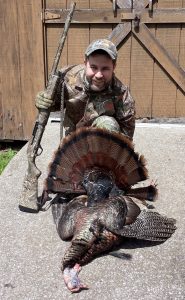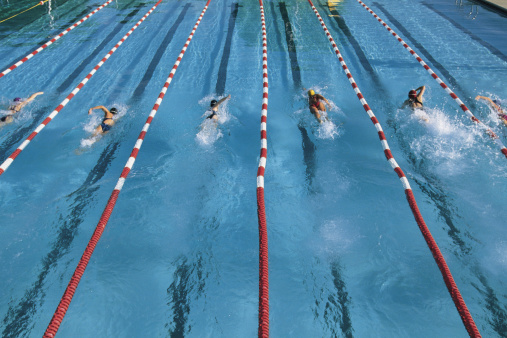Spring Turkey Hunting II
The sound of the gobble was so close that the hair on the back of my neck stood up and pushed my hat over my eyes. I had heard some crunching among the leaves in the woods behind me, but figured it was a squirrel because I hadn’t heard a single gobble in response to my twenty minutes of calling. The gobbler had snuck in silently.

This turkey was so close that I could smell his breath, or maybe was it mine bouncing off my facemask back at me. I tried to stay calm but my heart hadn’t got the memo; my pulse was racing my breath to see which could come in the shortest intervals.
No matter how many turkeys I’ve harvested over the thirty years I’ve been chasing them, I still get that same adrenalin rush as I did for my first.
Without moving my head, I looked as hard left as my eyeballs would bend. I could see this giant bird moving by just a few yards from the big maple tree I was leaning against. Luckily, he was focused on the Dave Smith hen decoy I had placed out at the edge of the field and not at me. That is one major reason to use a decoy. It is not so much that they attract a gobbler as that they take the bird’s attention away from the hunter. As the giant butterball stepped onto the field he popped into full strut, trying to look as cool as possible to impress this new chick. I know I was impressed, he looked as big as a Boeing 747. His beard was so long it was dragging in the damp grass and his fan was perfect. My camoed 12 gauge was in the ready position on my knee but, unfortunately, was not in line with the turkey now thirty yards away. I moved the gun barrel at a snail’s pace to try and line up for a shot but the weapon suddenly stopped dead as it hit a small sapling. This tiny tree couldn’t have been in a worst spot and prevented me from getting my bead on this monster’s melon. There was no way I could get a shot unless I lifted my barrel up and over the sapling. Deep down I knew this was too much movement. A wild turkey has the eyesight of an eagle and the eyes on the side of his head allow him see close to 360 degrees.
But he was in full strut now, completely in love with my hen decoy and he was now facing directly away from me. Maybe his fan would block his view of my movement. I held my breath and slowly lifted the camoed gun barrel up and around the sapling. Suddenly I to heard a sharp Putt, Putt, Putt … the alarm call of a turkey. My gobbler had picked up on my movement and was now out of strut and starting to move away. My only hope at this point was to finish my maneuver as quickly as possible and pray my gobbler would hang a few more seconds. As I made the sudden move the bird turned on the afterburners and ran like he had seen the devil himself as he covered 100 yards in the blink of an eye, passing a roadrunner and two cheetahs on his sprint. I hadn’t even gotten my gun half way to my shoulder. Man … if I had a dollar for each time I had tried to outdraw a gobbler and lost I would be down in Mar-A-Largo with Trump on the weekends. What can I say? That rush of excitement causes my brain to overreact. Plus the fact that I’m an extremely slow learner. Lucky for me I’m persistent.
Before I get too longwinded again as I did last week, I’d better get you readers some tips from someone who actually knows what they are talking about. I reached out to Don Sikorski of Batavia. Don is one of the best turkey hunters I’ve ever known, and I’ve known hundreds. Don has a passion for turkey hunting that few can match. He schedules his life around turkey season each May and it would take the Pope coming over for dinner to have him change his plans. Even then, if it was the opener the Pope would have to reschedule.
Here is what Don suggested: “The real key to having consistent success as a turkey hunter is finding hot gobblers … a gobbler without hens. It really boils down to the simple fact that a gobbler will come to a half-decent hen yelp if he is alone. If he has hens already, chances are he won’t. This does not mean you can’t call a gobbler in that has hens, and I’ve done so many times, but your odds of doing so are much slimmer. That is why I like to hunt aggressively. I will hunt one location for the first hour or so of the morning, then I will start moving and don’t sit down in the woods again until I actually get an answer (gobble). You could say that I troll for a gobbler.
“My hunting partner Bob McGraw and I have been hunting the same area in the southern tier of New York for close to forty years now. Over that time, we have obtained hunting permission on a good deal of ground in our area so we will have plenty of room to cover ground and call. We have learned over the years that our odds of scoring go way up if you find a lonely gobbler and the best way to do that is to cover ground and calling every so often.
“Bob and I have a milk route, so to speak. We drive from spot to spot. In some cases, we call right from the road and in others we will walk way back into a woodblock and call. If we don’t get an answer, we turn around and walk all the way back out again never setting foot in the woods. We don’t hunt this way because we are lazy, we do it because calling from a distance means we aren’t boogering up our spots with excessive human activity. We believe that the less the turkeys in our area lay eyes on hunters in their woods the better. Many times, we will return to a spot a second or even a third time hoping the gobblers we know are in the area have lost their hens. We have scored several times over the years on our third time calling to location on a given day. If we had gone into the woods the first time and started tromping around and calling, we would have educated all the turkeys in that spot and ruined that location possibly for the season. By calling from a distance you can hunt that spot several times a day all season long.
I want to thank Don for his tips here and for all the tips he has given me over the years. Without his help in my early days of turkey hunting I would surely have gotten discouraged and given up. Thanks Don!
New York’s turkey harvest numbers have been going down now since 1999. Last year, for example, spring turkey hunters harvested 17,492 birds. That was one thousand birds lower than 2016, and the lowest since the early 90’s There are many reasons for this – a wet nesting season in May and early June being number one, but predators are a close second. Western New York has more predators than most people know, starting with: coyote, red fox, grey fox, great horned owl, red-tail hawk, crow, raccoon, opossum, skunk, mink and weasel, feral cats and, of course, man. Many of these are nest predators which are actually worse than say a coyote or a hawk, because a nest predator such as a raccoon, opossum or skunk cannot catch a full-grown turkey; but they sure love their eggs. Come nightfall in the spring that is when they start grocery shopping by searching for ground-nesting turkey, pheasants or songbird eggs, destroying the whole clutch. It’s a wonder any turkeys survive with so many predators after them. All our wild pheasants are gone for that same reason.
Spring is the greatest time to be in the outdoors, you turkey hunters know this, so set you alarm to that insanely early hour and get out there. Remember to be safe and know your target. There is never a valid excuse to shoot at a sound.




